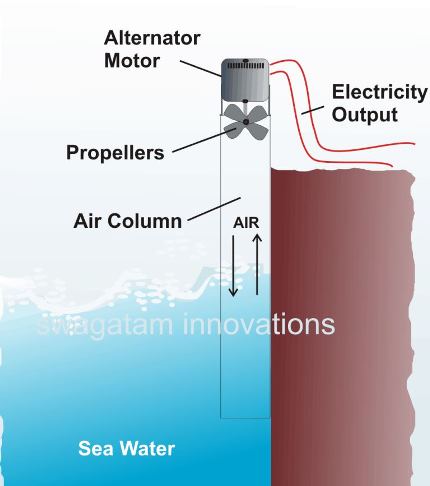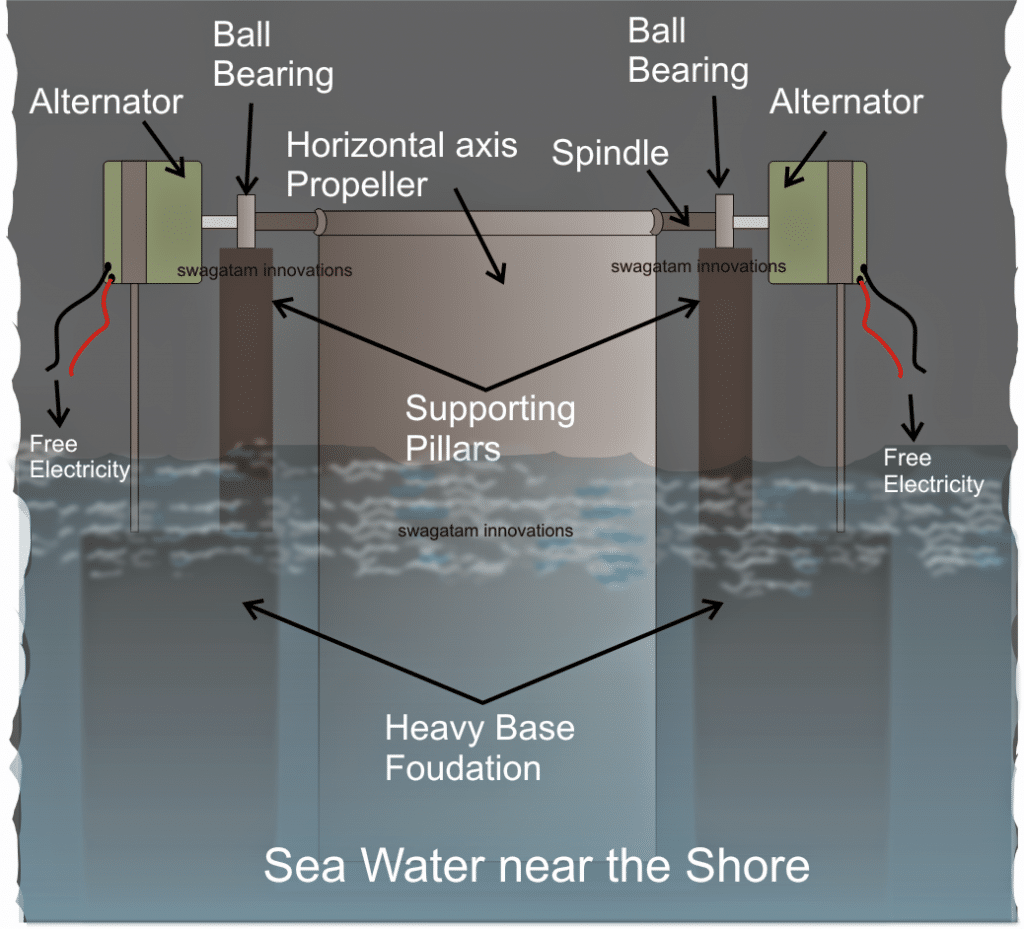In this post we investigate a couple of quick and efficient methods of generating free electricity from the sea waves which is limitless and an infinite source of energy.
Introduction
Just like wind and sun, sea is another example of massiveness and a potential raw energy source that may be harnessed for acquiring electrical power. Yes, just as solar or wind power, sea surfs can also be effectively dimensioned and converted for generating electricity. How? We’ll learn in this article through one simple experimental set up.
Probably there would be hardly anybody who might not have visited the sea shore. We all have enjoyed the sea water and its exciting waves and the surfs. And definitely we all know and experienced the power of this natural attribution.
Sea surfs are powerful and nevertheless are consistently happening and will be available almost forever.
These rise and ebbs of the sea water has quite attracted the researcher and have compelled them to think seriously about ways of converting this useful force of nature to the benefit of the mankind.
I being a great admirer of nature truly appreciate this approach by the many researchers and strongly believe that indeed sea water is one of the important sources that can be harnessed for generating electricity that would light up not only homes but cities.
How the Set Up Works
A very simple experimental set up is discussed her, that would interest and enlighten the readers regarding how to generate electricity from sea water through pretty ordinary means and installations.


Referring to the figure below we see that the set up is especially intended for exploiting the rise and the fall of the sea water ebbs or rather the giant waves and the surfs.
During the rising stance of the wave, we may notice a significant increase in the level of the sea water for the relevant section of the water.
This instantaneous increase in the level of the sea reduces to minimal levels when the water ebbs out or when the waves crashes down to repeat the cycle afresh.
This ongoing process if trapped inside an enclosed area effectively simulates a pumping or piston like action. In other words, the above operation of the sea water generates a powerful push pull effect of the air column inside the enclosed area.
Transforming Sea Waves into Pressurized Air Column
The concept can be easily understood be referring to the figure.
Now, the above explained push pull effect of the air inside the shown barrel or the pipe like structure when introduced across a propeller, makes it spin in a to and fro motion corresponding to the gushing and retrieving air content inside the column.
The diagram shows, how the above propeller may be integrated to an alternator spindle for instantly converting the rotation into pure usable electricity.
However one small drawback makes the whole set up a bit complicated. Since the fluctuations of the sea water is not constant and may vary drastically depending upon the climatic conditions, the generated electricity will also vary abruptly and generate electricity at non standard rates, dangerous for the many sophisticated appliance sin our homes.
Therefore the set up would require additional stabilizing equipment and stages for making the generated electricity compatible and safe with our domestic appliances.
However, set up can be safely and easily used for charging batteries by adding a straightforward electronic circuit stage.
As shown in the figure, the circuit is nothing but an ordinary voltage regulator circuit, employing the popular 78XX IC.
Using Bridge Rectifier for Rectifying the Negative Cycles
The generated unstable electricity is first rectified by the bridge configuration and filtered appropriately by the filter capacitor. This filtered DC is fed to the input of the voltage regulator IC, which does the rest by controlling and keeping the voltage under check and safe for charging the connected battery.
The battery is charged safely, once it gets fully charged, it may be used for operating an inverter.
Safe and absolutely Free electricity that may be used just for ever.
Electricity from Sea Surfs
The next set up I have explained below is also a fairly easy to implement design and can used for generating huge quantities of free electricity from sea wave continuously.
Renewable Electricity from Sea
AS already discussed above, just like wind and solar power, another great source of free energy available on the surface of this planet is the sea or the ocean water.
The power from sea or ocean is normally in the form of wave power, which is rather cheaper and much easier to harness compared to wind or solar power. This is because the force or power impact of sea wave on a given cross section can be much higher than wind or solar power across the same area.
This set up which will generate electricity from sea waves or surfs can be seen in the following diagram. The set up once built can be lifted and anchored in sea water close to the sea shore for acquiring free electricity throughout the year without interruption.

The Sea Generator Setup
In the image above we can see a vertical long flap made up of a rigid plastic which is hoisted on a horizontal spindle, supported by two ball bearings at the ends, such that the spindle and the flap assembly is able to hang and oscillate in a see-saw form freely, across the two ball bearings.
The ball bearings are supported over two adjacent vertical long pillars which are in turn clamped firmly on heavy metallic bases.
The spindle ends across the ball bearings can be seen fitted with the two respective alternators, which implies that when the spindle goes through a lateral push and pull , the same is transferred across the alternator shafts which in turn enables their internal coil and magnet mechanism to go through a corresponding to and fro kicking movements.
The push pull thrust on the vertical propeller flap is generated by the sea waves since the flap is immersed in the sea water up to 60% of its entire length.
The above push pull, sea-saw like movement of the flap produces an identical movement of the alternator shaft causing a proportionate amount of electricity to be generated across the respective output wires of the alternators.
Electricity for Charging Batteries
This free electricity can be used for charging batteries which could be later taken out for powering LED lights or inverters.
The base structure which supports the two pillars and the entire mechanism must be substantially heavy (made from solid steel) and rounded at the corners (for ensuring minimum resistance to the waves). The bottom surface of the base must be as flat as possible for preventing the unit from sinking in the soft sand.
Once built, the entire structure may be simply lifted ( by a few men) and installed inside sea water close to shore or wherever one may choose to position it inside the sea water.
Hi
How much is cost for the equipment and installation charges.can you please explain in detail
You will have to work it out yourself depending on the magnitude of the set up…
Thanks I am a mother and very busy! This helped me alot!
Glad you liked it, keep up the good work!